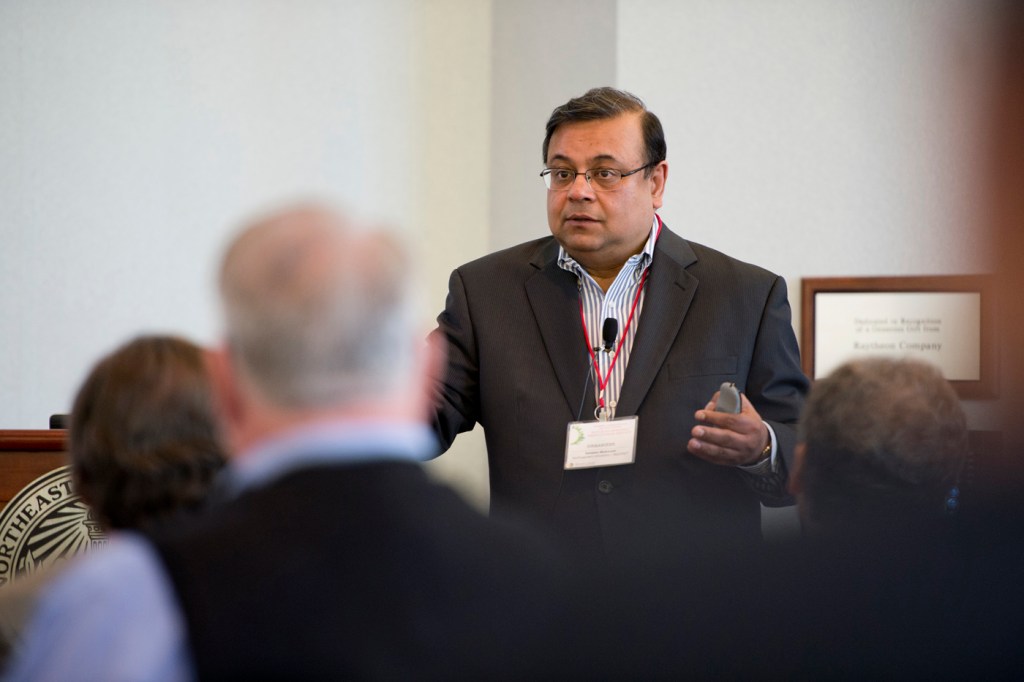Where to put all the energy

Northeastern University convened experts from industry, government, and academia last week to discuss advancements in next-generation energy storage and battery technologies as well as their commercial viability, which could have a major impact in addressing global challenges in areas such as energy consumption, materials shortages, and climate change.
The second-annual Multi-Scale Renewable Energy Storage Conference was held last week in the Raytheon Amphitheater. It was organized by the Northeastern University Center for Renewable Energy Technology, or NUCRET, and was sponsored by the College of Science and the Department of Chemistry and Chemical Biology.
Researchers at NUCRET, directed by professor of materials/physical chemistry Sanjeev Mukerjee, are pursuing a range of innovative energy research projects in the areas of transportation, alternative fuels, and energy storage, and advanced materials and processes for energy conversion. One, led by Mukerjee, involves developing cleaner, more efficient fuel cells to replace cars’ internal combustion engines. To overcome the cost barrier, they’re replacing platinum with materials like iron and cobalt to create less expensive catalysts.
In opening remarks, J. Murray Gibson, founding dean of the College of Science, cited his recent trip to his native Scotland to illustrate how the intermittent nature of renewable energy sources remains a major challenge. He said wind and rain from Hurricane Bertha dominated the weather there, noting that these conditions were perfect for hydroelectric power and wind power but miserable for capturing solar power, since the sun was hardly seen.
“You all understand how important storage is going to be if we’re going to create a sustainable world that relies on renewable energy,” Gibson said.
Throughout the MRES 2014 conference, researchers and industry leaders discussed innovative approaches in the works across a range of applications, from smart grids to military backpacks to electric car batteries. Several presenters focused on advancements with redox flow batteries, one class of electrochemical energy storage devices. Other presentations featured sodium-based battery technologies, strategies to better harness solar and wind energy, and hydrogen-based solutions for energy storage in smart grids.
The event aligned with Northeastern’s focus on pursuing use-inspired, interdisciplinary research focused on solving global challenges, particularly in the areas of health, security, and sustainability.

J. Murray Gibson, founding dean of the College of Science, speaks in Raytheon Amphitheater on the first day of the Multi-Scale Renewable Energy Storage Conference at Northeastern. Photo by Brooks Canaday.
On the first day of the conference, Imre Gyuk, program manager in energy storage for the Department of Energy, delivered a keynote address on progress in U.S. grid energy storage. He highlighted several federal stimulus-funded energy projects nationwide, including one that broke ground this month in Vermont that would generate and store solar energy to power an emergency shelter at Rutland High School during a storm.
He stressed the importance of developing energy storage for emergency preparedness, noting that investments in protection measures can save four times that investment in potential post-storm repairs. As he put it, “It’s going to happen, so you might as well fix your roof before the storm, not after it.”
For its part, NUCRET’s interdisciplinary team of faculty, students, and staff research ways to develop renewable energy, work that has been funded by the Department of Energy, Department of Defense, the U.S. Army, among many other sources. K.M. Abraham, a research professor at NUCRET, has been working on lithium battery technology for the better part of 30 years, with a particular focus on his pioneering work on rechargeable lithium-ion and lithium-air batteries.
At the conference, Abraham noted that the widespread use of lithium-ion batteries in consumer products has led to the rapid increase in their energy and power densities in recent years. He added that storage is the “next frontier” for lithium-ion but cautioned that “cost remains a primary deterrent to their widespread use in large-format applications, such as electric power grids.”
Though work on lithium-air battery technology has ramped up in recent years, it remains in its infancy, Abraham said. Recently, Volkswagen and Toyota have reportedly been exploring the technology for their next-generation energy-efficient vehicles.





